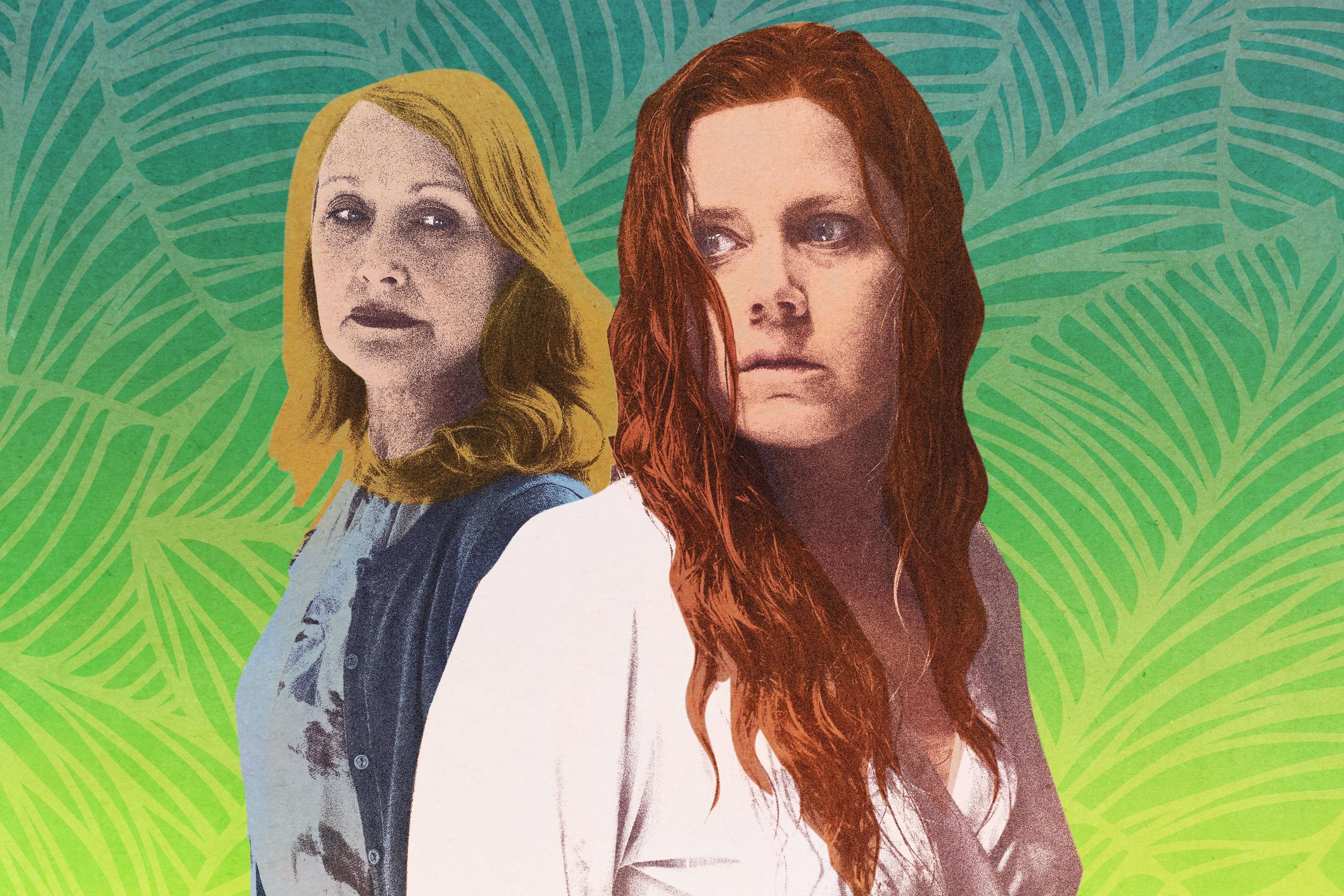

The prevailing season-long criticism against Sharp Objects wasn’t that the show was withholding information, but that it lacked any revelations about the murder mystery at its center. Indeed, the HBO miniseries has leaned far more into its unsettling mood than the mystery of who gruesomely killed two teenage girls and removed their teeth with pliers. There’s a serial killer in Wind Gap, Missouri, but nobody seems to mind—that has included the people making the show.
The manner in which Sharp Objects has prioritized its creepy Southern Gothic vibe and the darkness inherent to the town at the expense of whodunit storytelling brings to mind the initial two-season run of Twin Peaks, which, as cocreator David Lynch has famously said, never intended to solve the mystery of who killed Laura Palmer. Laura was, for all intents and purposes, a human MacGuffin. Her murder served as the entry point to a bizarre, beguiling town, the people who inhabited it, and the malicious supernatural forces at play—but when Laura’s killer was revealed partway through the second season at the behest of ABC, the show suffered a precipitous ratings dip that led to its cancellation. For the majority of Twin Peaks viewers in the ’90s, the murder mystery was what ultimately mattered—even though it didn’t matter to Lynch. For a small legion of Sharp Objects detractors who feel the series has lacked direction, or is downright boring, a similar critique has caught on: Meandering mood and impressive editing isn’t enough to overshadow the looming mystery that drives the show’s plot. The critiques of Sharp Objects are a reminder that if a show has a mystery in it, many will only be clamoring for it to be solved, even if that resolution isn’t the creator’s top priority.
One saving grace for those begrudgingly sticking it out with Sharp Objects was the knowledge that a clear resolution was bound to come in the finale. The show was not headed for a second-season renewal. Unless a Big Little Lies situation arises—and HBO’s president of programming, Casey Bloys, has vowed that one will not—the story of the miniseries would begin and end according to the events of Gillian Flynn’s novel. In Sunday night’s series finale, “Milk,” answers would arrive in one form or another, and would at least be conclusive.
As we approached the finale, the show was barreling toward an ending with one meaningful reveal, as well as potentially deadly consequences. In the penultimate episode, Camille Preaker (Amy Adams) surmises that her mother, Adora (Patricia Clarkson), likely has Munchausen syndrome by proxy—meaning that she’s been poisoning her own daughters out of fear that they won’t need her anymore. That episode concluded with Camille rushing back to the family estate, fearing for her half sister Amma’s life, and recalling the death of her sister Marian, now understood to have been caused by Adora.
As promised, “Milk” does provide clear and definitive answers. By the time the credits roll, we’ve learned that Adora was, in fact, responsible for killing her daughter—and that she nearly did the same to Amma and Camille, who willingly got herself poisoned to divert attention away from an ailing Amma. Adora is arrested; in her house, bloody pliers are found and confiscated as evidence. With Adora behind bars, Camille takes Amma back to St. Louis to begin her life anew. However, not long after the two sisters have settled into a new routine, Camille discovers a row of teeth in Amma’s dollhouse-sized replica of her home; the teeth are used as makeshift ivory to mimic the floor of one of the rooms in the Crellin estate.
“Don’t tell Mama,” Amma pleads, with a hauntingly ambiguous expression.
The reveal of Amma’s guilt lands with a punch—and is punctuated by a couple of hazy post-credit scenes that flash through of Amma killing Ann, Natalie, and possibly a third girl in St. Louis, as well as Amma wearing an all-white gown in the woods (recalling the Wind Gap boy previously telling Camille about a “woman in white” snatching the victims). For as much as Sharp Objects diverged from and subverted the whodunit narrative, the answers, and the killer(s), were staring at us all along.
Sharp Objects’ focus from the onset was its trio of women: Camille, Adora, and Amma were our window into a town built on violence. The murder mystery and the show’s unnerving tone weren’t mutually exclusive—they informed each other, while the dynamics among the three women and the trauma passed down through the family continued to evolve. In the end, Sharp Objects was able to have its cake and eat it too: It could be a compelling treatise on a town stained by sin and complicity, a brooding character study, and a mystery with one heck of a twist.
The best kinds of mysteries don’t just inform the viewer, they allow the viewer to revisit key scenes and see what was evident the whole time. Amma’s behavior throughout Sharp Objects was disarming and borderline sociopathic, but perhaps felt less pronounced because there were so many other balls in the air, including Camille’s traumatizing and continually resurfacing past. Similarly, Adora’s disease is more obvious looking back on early episodes—her hatred for Camille stems from her daughter’s independence. Like the show’s elliptical editing that veered between the dreamy and the nightmarish, what feels hazy in the moment is given a particularly chilling clarity when the puzzle is made whole. Guilt is everywhere.
For as culpable as Adora is for poisoning Amma repeatedly—as Detective Willis notes at the hospital, she’d likely built up a tolerance to a deadly concoction that included antifreeze, prescription drugs, and rat poison—and Amma is for, well, committing the murders, it’s Wind Gap’s complicity that feels most resonant. Whether it was turning the other cheek to Adora’s domestic terrors, as Chief Vickery and Jackie O’Neill did for years, letting “boys be boys” and sexually victimize Camille and other teen girls, or literally participating in the murders of Ann and Natalie (in the post-credit scenes, Amma’s two roller-skating buddies appear to be next to her), Wind Gap allowed awful violence toward women to pervade the town for decades. It never moved past Millie Calhoun’s savage rape and murder at the hands of Union soldiers during the Civil War, the story on which the town was founded. Wind Gap’s perverse annual holiday, Calhoun Day, wasn’t just a memorial, but a yearly institutionalization of horrific and unavoidable violence.
A picturesque little town that seems pleasant enough from far away but carries untold horrors within its community—no wonder Sharp Objects feels so much like a spiritual cousin to Twin Peaks, right down to each show’s eerie walls of forest that emanate an intangible malevolence. But unlike Twin Peaks, which established the long-prevailing dead-girl trope that has since been copied by myriad TV dramas, Sharp Objects didn’t just have a mystery to unravel, but a story to tell about how that mystery related to and drove its protagonist’s trauma. Camille’s reckoning with the town that made her—a place that once drove her to self-harm—is the show’s emotional coda, made all the more painful when Amma is revealed to be Wind Gap’s killer, and the town’s vicious cycle repeats itself.
Without the palatability and unabashedly entertaining soap opera gimmicks of Big Little Lies—director Jean-Marc Vallée’s previous miniseries for HBO, which also orbited a whodunit and boasted an all-star cast—Sharp Objects didn’t lend itself to the same campy satisfactions. Oftentimes, it was brutal to watch. But the series accomplished its goals. Sharp Objects is a harrowing tale with singular characters, an absorbing atmosphere, and, in the end, propulsive twists that cut deep and provide a proper payoff. Like the Woman in White, it lured us into the woods, and we can’t go back.
Disclosure: HBO is an initial investor in The Ringer.

